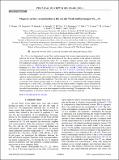Files in this item
Magnetic surface reconstruction in the van der Waals antiferromagnet Fe1+xTe
Item metadata
| dc.contributor.author | Trainer, C. | |
| dc.contributor.author | Songvilay, M. | |
| dc.contributor.author | Qureshi, N. | |
| dc.contributor.author | Stunault, A. | |
| dc.contributor.author | Yim, C. M. | |
| dc.contributor.author | Rodriguez, E. E. | |
| dc.contributor.author | Heil, C. | |
| dc.contributor.author | Tsurkan, V | |
| dc.contributor.author | Green, M. A. | |
| dc.contributor.author | Loidl, A. | |
| dc.contributor.author | Wahl, P. | |
| dc.contributor.author | Stock, C. | |
| dc.date.accessioned | 2021-02-04T16:30:18Z | |
| dc.date.available | 2021-02-04T16:30:18Z | |
| dc.date.issued | 2021-01-06 | |
| dc.identifier | 272467337 | |
| dc.identifier | 83fdb141-4e8c-4d2d-bccc-c2221753c354 | |
| dc.identifier | 85099303612 | |
| dc.identifier | 000605110200002 | |
| dc.identifier.citation | Trainer , C , Songvilay , M , Qureshi , N , Stunault , A , Yim , C M , Rodriguez , E E , Heil , C , Tsurkan , V , Green , M A , Loidl , A , Wahl , P & Stock , C 2021 , ' Magnetic surface reconstruction in the van der Waals antiferromagnet Fe 1+x Te ' , Physical Review B , vol. 103 , no. 2 , 024406 . https://doi.org/10.1103/PhysRevB.103.024406 | en |
| dc.identifier.issn | 2469-9950 | |
| dc.identifier.other | Bibtex: ISI:000605110200002 | |
| dc.identifier.other | ORCID: /0000-0002-8635-1519/work/87404172 | |
| dc.identifier.uri | https://hdl.handle.net/10023/21377 | |
| dc.description | We acknowledge financial support from the EPSRC (EP/R031924/1 and EP/R032130/1) and NIST Center for Neutron Research. C.H. acknowledges support by the Austrian Science Fund (FWF) Project No. P32144-N36 and the VSC4 of the Vienna University of Technology | en |
| dc.description.abstract | Fe1+xTe is a two-dimensional van der Waals antiferromagnet that becomes superconducting on anion substitution on the Te site. The properties of the parent phase of Fe1+xTe are sensitive to the amount of interstitial iron situated between the iron-tellurium layers. Fe1+xTe displays collinear magnetic order coexisting with low-temperature metallic resistivity for small concentrations of interstitial iron x and helical magnetic order for large values of x. While this phase diagram has been established through scattering [see, for example, E. E. Rodriguez et al., Phys. Rev. B 84, 064403 (2011); S. Rossler et al., ibid. 84, 174506 (2011)], recent scanning tunneling microscopy measurements [C. Trainer et al., Sci. Adv. 5, eaav3478 (2019)] have observed a different magnetic structure for small interstitial iron concentrations x with a significant canting of the magnetic moments along the crystallographic c axis of θ = 28° ± 3°. In this paper, we revisit themagnetic structure of Fe1.09Te using spherical neutron polarimetry and scanning tunneling microscopy to search for this canting in the bulk phase, and we compare surface and bulk magnetism. The results show that the bulk magnetic structure of Fe1.09Te is consistent with collinear in-plane order (θ= 0 with an error of ∼ 5°). Comparison with scanning tunneling microscopy on a series of Fe1+xTe samples reveals that the surface exhibits a magnetic surface reconstruction with a canting angle of the spins of θ = 29.8°. We suggest that this is a consequence of structural relaxation of the surface layer resulting in an out-of-plane magnetocrystalline anisotropy. The magnetism in Fe1+xTe displays different properties at the surface when the symmetry constraints of the bulk are removed. | |
| dc.format.extent | 10 | |
| dc.format.extent | 1461708 | |
| dc.language.iso | eng | |
| dc.relation.ispartof | Physical Review B | en |
| dc.subject | QC Physics | en |
| dc.subject | TK Electrical engineering. Electronics Nuclear engineering | en |
| dc.subject | NDAS | en |
| dc.subject.lcc | QC | en |
| dc.subject.lcc | TK | en |
| dc.title | Magnetic surface reconstruction in the van der Waals antiferromagnet Fe1+xTe | en |
| dc.type | Journal article | en |
| dc.contributor.sponsor | EPSRC | en |
| dc.contributor.institution | University of St Andrews. School of Physics and Astronomy | en |
| dc.contributor.institution | University of St Andrews. Centre for Designer Quantum Materials | en |
| dc.contributor.institution | University of St Andrews. Condensed Matter Physics | en |
| dc.identifier.doi | 10.1103/PhysRevB.103.024406 | |
| dc.description.status | Peer reviewed | en |
| dc.identifier.grantnumber | EP/R031924/1 | en |
This item appears in the following Collection(s)
Items in the St Andrews Research Repository are protected by copyright, with all rights reserved, unless otherwise indicated.

